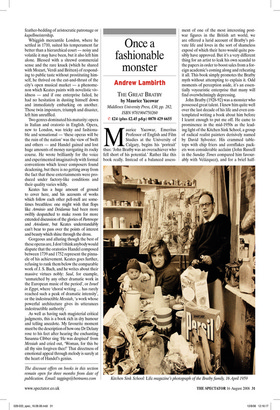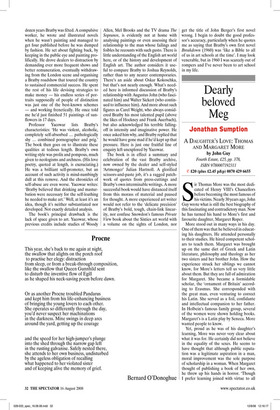Once a fashionable monster
Andrew Lambirth
THE GREAT BRATBY by Maurice Yacowar Middlesex University Press, £30, pp. 282, ISBN 9781904750260 ✆ £24 (plus £2.45 p&p) 0870 429 6655 Maurice Yacowar, Emeritus Professor of English and Film Studies at the University of Calgary, begins his ‘portrait’ thus: ‘John Bratby was an overachiever who fell short of his potential.’ Rather like this book really. Instead of a balanced assess ment of one of the most interesting postwar figures in the British art world, we are offered a lurid account of Bratby’s private life and loves in the sort of shameless exposé of which their hero would quite possibly have approved. But it’s a very different thing for an artist to leak his own scandal to the papers in order to boost sales from a foreign academic’s coming along and reheating it all. This book simply promotes the Bratby myth without attempting to explain it. Odd moments of perception aside, it’s an essentially voyeuristic enterprise that many will find overwhelmingly depressing.
John Bratby (1928-92) was a monster who possessed great talent. I knew him quite well over the last decade of his life and even contemplated writing a book about him before I learnt enough to put me off. He came to prominence in the mid-1950s as the leading light of the Kitchen Sink School, a group of radical realist painters derisively named by David Sylvester. His crammed tabletops with chip friers and cornflakes packets won considerable acclaim (John Russell in the Sunday Times compared him favourably with Velázquez), and for a brief half dozen years Bratby was fêted. A compulsive worker, he wrote and illustrated novels when he wasn’t painting and managed to get four published before he was dumped by fashion. He set about fighting back, by keeping in the public eye and painting prolifically. He drove dealers to distraction by demanding ever more frequent shows and better remuneration, eventually withdrawing from the London scene and organising a Bratby roadshow that toured the country to sustained commercial success. He spent the rest of his life devising strategies to make money — his endless series of portraits supposedly of people of distinction was just one of the best-known schemes — and working frenetically. He once told me he’d just finished 51 paintings of sunflowers in 17 days.
Professor Yacowar lists Bratby’s characteristics: ‘He was violent, alcoholic, completely self-absorbed ... pathologically shy ... combined pornographer and prig.’ The book then goes on to illustrate these qualities at tedious length. Bratby’s own writing style was prolix and pompous, much given to neologisms and archness. (His love poetry, quoted at length, is excruciating.) He was a brilliant self-promoter, but an account of such activity is mind-numbingly dull at this remove. And the chronicles of self-abuse are even worse. Yacowar writes: ‘Bratby believed that drinking and masturbation were necessary for the self-loathing he needed to make art.’ Well, at least it’s an idea, though it’s neither substantiated nor developed. Not exactly detailed analysis.
The book’s principal drawback is the lack of space given to art. Yacowar, whose previous credits include studies of Woody Allen, Mel Brooks and the TV drama The Sopranos, is evidently not at home with analysing paintings or even assessing their relationship to the man whose failings and foibles he recounts with such gusto. There is little understanding of the English art world here, or of the history and development of English art. The author considers it useful to compare Bratby to Joshua Reynolds, rather than to any nearer contemporaries. There’s an aside about Oskar Kokoschka, but that’s not nearly enough. What’s needed here is informed discussion of Bratby’s relationship with Augustus John (who fascinated him) and Walter Sickert (who continued to influence him). And more about such figures as Carel Weight, who always considered Bratby his most talented pupil (above the likes of Hockney and Frank Auerbach), but also acknowledged his terrible fallingoff in intensity and imaginative power. He once asked him why, and Bratby replied that he would have gone mad if he’d kept up that pressure. Here is just one fruitful line of enquiry left unexplored by Yacowar.
The book is in effect a summary and celebration of the vast Bratby archive, now owned by the dealer and self-styled ‘Artmonger’ Julian Hartnoll. A glorified scissors-and-paste job, it’s a ragged patchwork of quotes from press-cuttings and Bratby’s own interminable writings. A more successful book would have distanced itself from this morass of material and paused for thought. A more experienced art writer would not refer to the ‘delicate precision’ of Bratby’s bold, tough, chain-link linearity, nor confuse Snowdon’s famous Private View book about the Sixties art world with a volume on the sights of London, nor get the title of John Berger’s first novel wrong. I begin to doubt the good professor’s accuracy, particularly when he quotes me as saying that Bratby’s own first novel Breakdown (1960) was ‘like a Bible to all of us in art schools at the time’. I may look venerable, but in 1960 I was scarcely out of rompers and I’ve never been to art school in my life.



























































 Previous page
Previous page